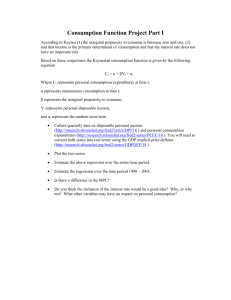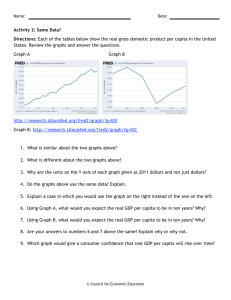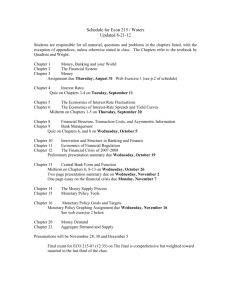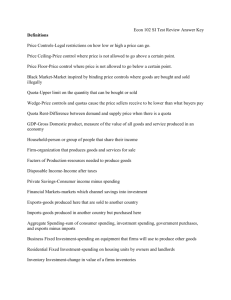14.3: Volatility in Price Level vs. Exchange Rates
advertisement
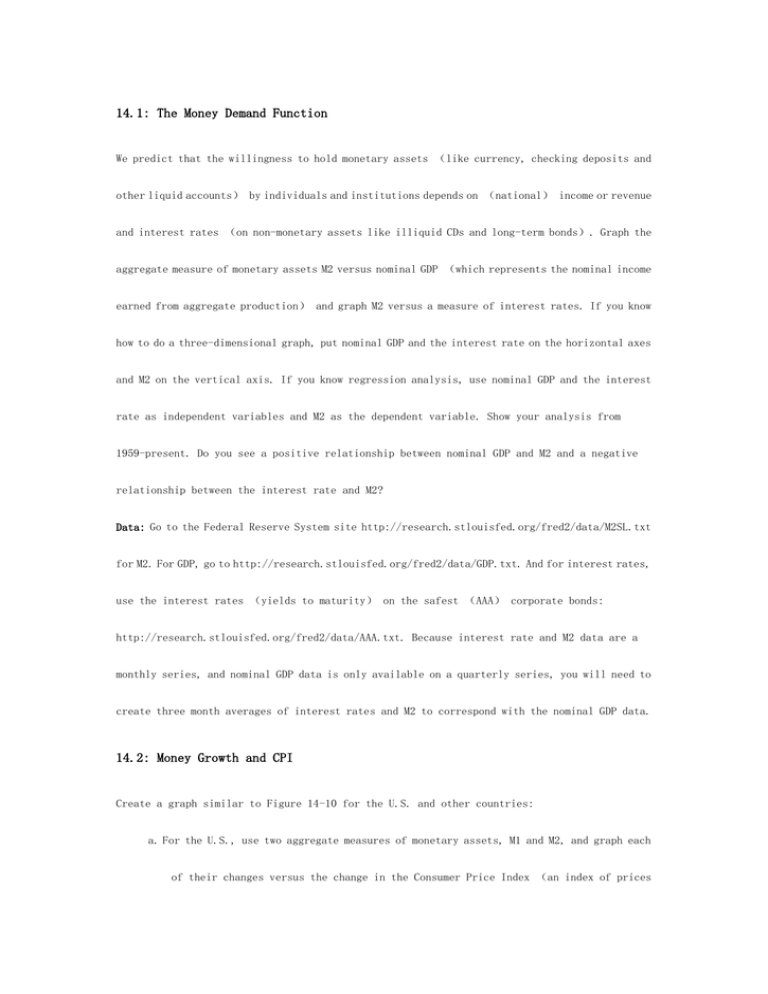
14.1: The Money Demand Function We predict that the willingness to hold monetary assets (like currency, checking deposits and other liquid accounts) by individuals and institutions depends on (national) income or revenue and interest rates (on non-monetary assets like illiquid CDs and long-term bonds). Graph the aggregate measure of monetary assets M2 versus nominal GDP (which represents the nominal income earned from aggregate production) and graph M2 versus a measure of interest rates. If you know how to do a three-dimensional graph, put nominal GDP and the interest rate on the horizontal axes and M2 on the vertical axis. If you know regression analysis, use nominal GDP and the interest rate as independent variables and M2 as the dependent variable. Show your analysis from 1959-present. Do you see a positive relationship between nominal GDP and M2 and a negative relationship between the interest rate and M2? Data: Go to the Federal Reserve System site http://research.stlouisfed.org/fred2/data/M2SL.txt for M2. For GDP, go to http://research.stlouisfed.org/fred2/data/GDP.txt. And for interest rates, use the interest rates (yields to maturity) on the safest (AAA) corporate bonds: http://research.stlouisfed.org/fred2/data/AAA.txt. Because interest rate and M2 data are a monthly series, and nominal GDP data is only available on a quarterly series, you will need to create three month averages of interest rates and M2 to correspond with the nominal GDP data. 14.2: Money Growth and CPI Create a graph similar to Figure 14-10 for the U.S. and other countries: a. For the U.S., use two aggregate measures of monetary assets, M1 and M2, and graph each of their changes versus the change in the Consumer Price Index (an index of prices that consumers pay) from 1987-2006. Does one aggregate measure appear more closely related to inflation than the other? Why might this be? b. For 5-10 other countries, graph the change in M2 versus the change in the level of average prices from 1987-2006 (or according to the available data). Does a close relationship appear for some countries and not for others? If you know regression analysis, use the change in M2 as an independent variable and the level of prices as a dependent variable. Does the independent variable explain most of the variability in the dependent variable (that is, is the R-squared high)? Also, remember that your sample size is small, so that the results should not be considered robust. Data: For part a., go to the Federal Reserve System site at http://research.stlouisfed.org/fred2/categories/24 to find data on M1 and M2. For the CPI, go to http://research.stlouisfed.org/fred/data/cpi/cpiaucsl. For part b., use the Bank for International Settlements site at http://www.bis.org, which has links to various central banks that provide data on aggregate measures of monetary assets (try to find consistent measures if you can). For the CPI, the Economagic website at http://www.economagic.com/blsint.htm provides data for several countries. Data on the CPI and aggregate measures of monetary assets for some countries has also been generously provided by the International Monetary Fund in this file macromonthly.xls. 14.3: Volatility in Price Level vs. Exchange Rates Create a graph similar to Figure 14-11 for the U.S and other countries. In particular, graph the exchange rates and relative level of average prices for Thailand and South Korea versus the U.S. Were there times when exchange rate volatility was very low? Why might this have been? Hint: Think about the exchange rate policies in these countries. What happened in 1997? Data: Price level data from many countries have been generously provided by the International Monetary Fund in the file macromonthly.xls. Scroll to the left to find the Consumer Price Index data. The Federal Reserve System site http://research.stlouisfed.org/fred2/categories/15 provides data on exchange rates.
